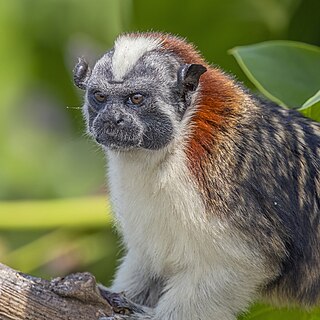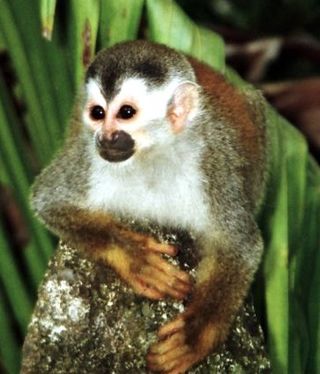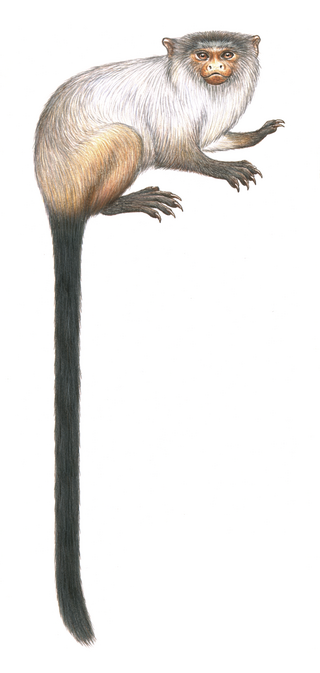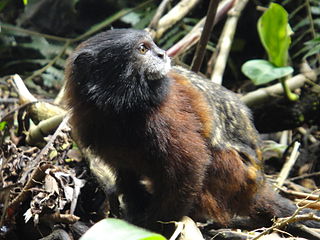
The Callitrichidae are a family of New World monkeys, including marmosets, tamarins, and lion tamarins. At times, this group of animals has been regarded as a subfamily, called the Callitrichinae, of the family Cebidae.

Geoffroy's tamarin, also known as the Panamanian, red-crested or rufous-naped tamarin, is a tamarin, a type of small monkey, found in Panama and Colombia. It is predominantly black and white, with a reddish nape. Diurnal, Geoffroy's tamarin spends most of its time in trees, but does come down to the ground occasionally. It lives in groups that most often number between three and five individuals, and generally include one or more adults of each sex. It eats a variety of foods, including insects, exudates, fruits and other plant parts. Insects and fruits account for the majority of its diet, but exudates are also important. But since its teeth are not adapted for gouging trees to get to the sap, it can only eat exudates when they are easily available.

The tamarins are squirrel-sized New World monkeys from the family Callitrichidae in the genus Saguinus. They are the first offshoot in the Callitrichidae tree, and therefore are the sister group of a clade formed by the lion tamarins, Goeldi's monkeys and marmosets.

The emperor tamarin is a species of tamarin monkey allegedly named for its resemblance to the German emperor Wilhelm II. It lives in the north Brazilian states of Acre and Amazonas and the southwest Amazon Basin, in east Peru, north Bolivia.

The moustached tamarin is a New World monkey and a species of tamarin. The moustached tamarin is named for the lack of coloring in the facial hair surrounding their mouth, appearing similar to a moustache. As with all New World monkeys, the moustached tamarin is found only in areas of Central and South America.

The brown-mantled tamarin, also known as Spix's saddle-back tamarin, is a species of saddle-back tamarin. This New World monkey is found in the Southern American countries of Bolivia, Brazil and Peru. This omnivorous member of the Callitrichidae family is usually found in smaller groups ranging between 4 and 15 individuals. This species communicates vocally and largely rely their olfactory system. The brown-mantled tamarin is considered as a species of Least Concern by the International Union for Conservation of Nature, despite a decreasing population and being threatened by poaching, habitat loss and capture for the illegal pet trade.

The Central American squirrel monkey, also known as the red-backed squirrel monkey, is a squirrel monkey species from the Pacific coast of Costa Rica and Panama. It is restricted to the northwestern tip of Panama near the border with Costa Rica, and the central and southern Pacific coast of Costa Rica, primarily in Manuel Antonio and Corcovado National Parks.

The golden-mantled tamarin is a tamarin species from South America. It is found in Ecuador and Peru, specifically in the upper Amazon (lowland), east of the Andes in Ecuador, and Northeast Peru; between the Rio Curaray and Rio Napo in Peru.

The white-mantled tamarin, Leontocebus weddelli melanoleucus, is a subspecies of Weddell's saddle-back tamarin, a tamarin monkey from South America. It is found in Brazil, between Rio Jurua and Rio Tarauacá.

The black-crowned Central American squirrel monkey is a subspecies of the Central American squirrel monkey. Its range is restricted to the Pacific coast of western Panama to the western portion of the Chiriquí Province and of southern Costa Rica, south of the Rio Grande de Terraba, including the Osa Peninsula. It is the subspecies of Central American squirrel monkey seen in Corcovado National Park in Costa Rica. Its type locality is David, Panama, but its range apparently no longer extends that far east.
Mura's saddleback tamarin is a subspecies of monkey that was first seen by scientists in 2007 in the Brazilian state of Amazonas. The monkey, which is mostly gray and brown, weighs 213 grams (7.5 oz), is 240 millimetres (9.4 in) tall, and has a 320 millimetres (13 in) tail.

Rondon's marmoset, also known as the Rondônia marmoset, is a small species of monkey from the family Callitrichidae found in the south-western Amazon in Brazil. It is endemic to the state of Rondônia, and its range bordered by the Rio Mamoré, Rio Madeira, Rio Ji-Paraná, Serra dos Pacaás Novos and possibly Bolivia. It was only described in 2010, and its name refers to the famous Amazonian explorer Cândido Rondon. Prior to its description, it was included in Emilia's marmoset.

The saddle-back tamarins are squirrel-sized New World monkeys from the family Callitrichidae in the genus or subgenus Leontocebus. They were split from the tamarin genus Saguinus based on genetic data and on the fact that saddle-back tamarins are sympatric with members of Saguinus to a greater extent than would be expected from two members of the same genus. However, this argument can be circular, as several other mammals show sympatry among congeneric species, such as armadillos, spotted cats, and fruit-eating bats. Some authors still consider Leontocebus to be a subgenus of Saguinus.

Cruz Lima's saddle-back tamarin is a species of saddle-back tamarin, a type of small monkey from South America. Cruz Lima's saddle-back tamarin was formerly considered to be a subspecies of the brown-mantled tamarin, L. fuscicollis. It lives in Brazil in the area near the Inauini River. Its fur is mostly reddish orange, with a black tail and white eyebrows. The IUCN rates it as least concern from a conservation standpoint.

Illiger's saddle-back tamarin is a species of saddle-back tamarin, a type of small monkey from South America. Illiger's saddle-back tamarin was formerly considered to be a subspecies of the brown-mantled tamarin, L. fuscicollis. It is closely related to the Andean saddle-back tamarin. It is endemic to the Peruvian Amazon and its type locality is in Loreto, Peru, at the left bank of the lower Rio Ucayali.

The Andean saddle-back tamarin is a species of saddle-back tamarin, a type of small monkey from South America. The Andean saddle-back tamarin was formerly considered to be a subspecies of the brown-mantled tamarin, L. fuscicollis. It is closely related to Illiger's saddle-back tamarin. It is endemic to Peru and its type locality is in the Department of Huanuco, Peru.

Geoffroy's saddle-back tamarin is a species of saddle-back tamarin, a type of small monkey from South America. Geoffroy's saddle-back tamarin was formerly considered to be a subspecies of the brown-mantled tamarin, L. fuscicollis. It lives in Loreto, Peru.

Lesson's saddle-back tamarin is a species of saddle-back tamarin, a type of small monkey from South America. Lesson's saddle-back tamarin was formerly considered to be a subspecies of the brown-mantled tamarin, L. fuscicollis. Genetic analysis showed it to be more closely related to the black-mantled tamarin than to the brown-mantled tamarin. Its type locality is in Colombia, in Plaines de Mocoa, Putumayo, between the Rio Putumayo and Rio Caqueta. It also lives in Brazil.

The red-mantled saddle-back tamarin is a species of saddle-back tamarin, a type of small monkey from South America. The red-mantled saddle-back tamarin was formerly considered to be a subspecies of the brown-mantled tamarin, L. fuscicollis. It lives in Ecuador and Peru and its type locality is in Peru, near the confluence of the Amazon River and the Napo River.

















